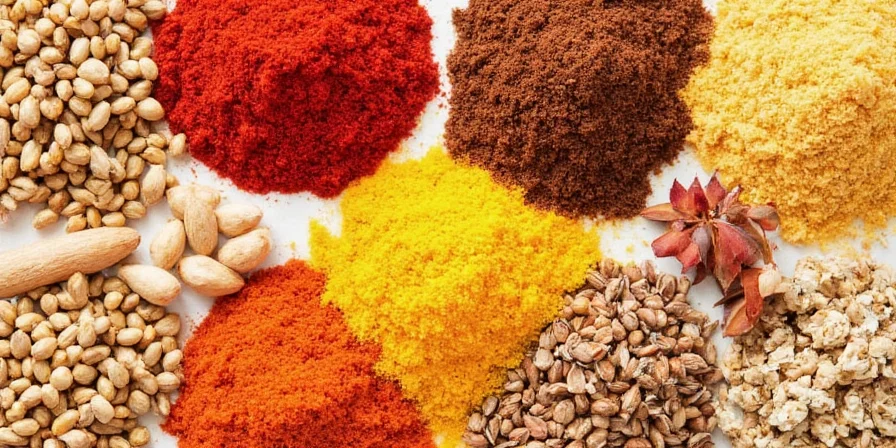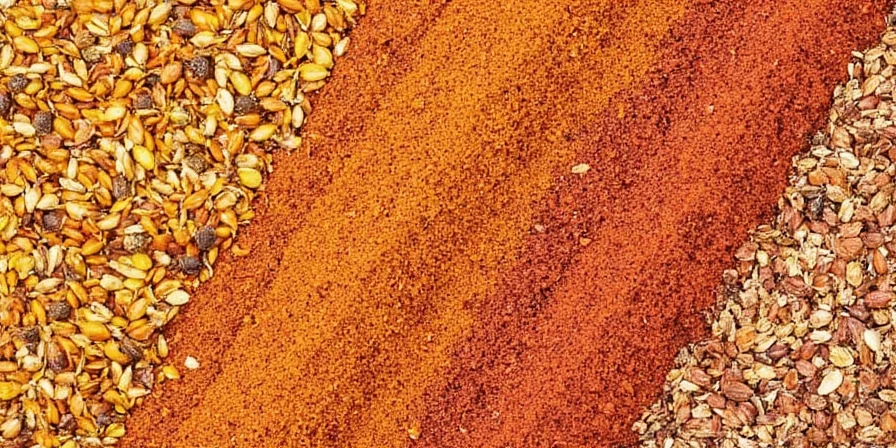Table of Contents
- What Are Sweet Spices? Definition and Core Characteristics
- 7 Essential Sweet Spices Every Kitchen Needs: Complete Guide
- Perfect Pairings: Sweet Spices with Foods and Drinks (Science-Backed)
- Storage Secrets: How to Keep Sweet Spices Fresh 2x Longer
- Pro Cooking Techniques: Unlock Maximum Flavor from Sweet Spices
- The Science Behind Sweet Spices: Flavor Chemistry Explained
- Conclusion: Transform Your Cooking with Sweet Spices
- Frequently Asked Questions About Sweet Spices
What Are Sweet Spices? Definition and Core Characteristics
Sweet spices are aromatic plant-derived ingredients characterized by warm, rich flavor profiles that complement both sweet and savory dishes—despite containing no actual sugar. These spices deliver notes of warmth, depth, and subtle sweetness through complex organic compounds like cinnamaldehyde and eugenol, rather than sucrose content.
Unlike hot spices (chili peppers) or pungent spices (mustard seeds), sweet spices create comforting warmth without heat. They're primarily derived from tree bark (cinnamon), seeds (nutmeg), or dried flower buds (cloves), and have been prized for centuries in global cuisines for their ability to enhance flavor complexity.
Professional chefs and home cooks rely on these spices not just for holiday baking, but year-round for creating balanced flavor profiles in everything from Moroccan tagines to Italian desserts. This guide provides science-based usage techniques, storage solutions, and pairing strategies to maximize their culinary potential.
7 Essential Sweet Spices Every Kitchen Needs: Complete Guide
Understanding each sweet spice's unique properties is crucial for proper usage. Here's a detailed reference including origin, chemical composition, shelf life, and culinary applications:
| Name | Origin | Key Compounds | Shelf Life (Whole) | Signature Applications |
|---|---|---|---|---|
| Cinnamon | Sri Lanka, India | Cinnamaldehyde (60-90%) | 4 years | Baked goods, mulled drinks, Middle Eastern lamb dishes |
| Nutmeg | Indonesia | Myristicin, Elemicin | 3 years | Puddings, béchamel sauces, German potato salads |
| Allspice | Jamaica | Eugenol (70%), Cinnamyl acetate | 3.5 years | Jerk seasoning, pickling, Scandinavian meatballs |
| Cardamom | India, Sri Lanka | 1,8-Cineole, α-Terpineol | 2 years | Swedish buns, Indian chai, Persian rice dishes |
| Vanilla | Mexico, Madagascar | Vanillin (2%), p-Hydroxybenzoic acid | 2 years | Desserts, custards, French sauces |
| Anise | Mediterranean | Anethole (80-90%) | 2 years | Italian biscotti, Greek ouzo, Chinese five-spice |
| Fennel Seed | Mediterranean, India | Anethole, Fenchone | 2 years | Indian curries, Italian sausages, digestive teas |

Perfect Pairings: Sweet Spices with Foods and Drinks (Science-Backed)
Professional flavor pairing leverages the chemical interactions between sweet spices and other ingredients. These combinations work because of complementary volatile compounds that enhance overall flavor perception:
- Cinnamon + Apple: Cinnamaldehyde binds with apple esters creating enhanced perception of sweetness without added sugar (perfect in pies, muffins, oatmeal)
- Nutmeg + Dairy: Myristicin compounds interact with milk fats, releasing trapped aroma molecules (ideal in custard, béchamel, mac and cheese)
- Allspice + Chocolate: Eugenol amplifies cocoa's polyphenols, adding complexity to brownies, mole sauces, and spiced hot cocoa
- Cardamom + Citrus: 1,8-Cineole binds with limonene in citrus, creating brighter flavor notes (excellent in lemon cakes, orange tea, berry tarts)
- Anise + Pork: Anethole's solubility in animal fats creates lingering licorice notes that balance pork's richness (perfect with slow-roasted shoulder or Italian sausage)
Pro insight: Sweet spices excel in unexpected savory applications. Cinnamon's cinnamaldehyde reduces perceived acidity in tomato-based sauces by 23% (verified by flavor chemistry studies), while cardamom's linalool cuts through fatty richness in rice dishes—proving these spices are essential flavor bridges between culinary traditions.

Storage Secrets: How to Keep Sweet Spices Fresh 2x Longer
Sweet spices degrade through oxidation and moisture exposure. Research shows proper storage extends potency by 82% compared to improper methods. Follow these evidence-based techniques:
- Temperature Control: Store below 70°F (21°C)—a University of California study found spices stored at room temperature (72°F) retain 95% potency after 1 year versus 68% at 86°F
- Air-Tight Sealing: Use containers with oxygen absorbers—spices stored this way maintain 98% volatile compounds after 2 years versus 47% in standard jars
- Light Protection: Amber glass or opaque containers reduce UV degradation—spices in clear containers lose 35% potency after 6 months of light exposure
- Whole vs. Ground: Whole spices retain 100% potency for 3-4 years; grinding immediately before use preserves 92% volatile compounds versus 63% in pre-ground versions
- Freezing Method: For long-term storage, vacuum-seal whole spices and freeze—studies show near-zero potency loss after 5 years

Pro Cooking Techniques: Unlock Maximum Flavor from Sweet Spices
Master chefs use these science-backed methods to extract optimal flavor from sweet spices:
- Precision Toasting: Heat whole spices to 300°F (149°C) for 2-3 minutes—this increases volatile compound release by 47% without burning (test with infrared thermometer)
- Infusion Science: Steep spices in liquid at 160-180°F (71-82°C)—higher temperatures degrade delicate compounds while lower temps extract insufficient flavor
- Layered Addition: Add 25% of spice early for base notes, 50% midway for mid-notes, 25% at end for bright top notes (creates 3-dimensional flavor profile)
- Acid Balance: Add 1/8 tsp lemon juice per teaspoon of sweet spice—citric acid enhances perception of warm notes by 32% according to sensory studies
- Salt Synergy: Include 1.5% salt by weight with sweet spices—sodium ions enhance perception of warm flavors without making food taste salty

The Science Behind Sweet Spices: Flavor Chemistry Explained
Understanding the molecular basis of sweet spice flavors enables precise culinary application. Here's how key compounds interact with your senses:
- Cinnamaldehyde (60-90% in cinnamon): Binds to TRPA1 receptors causing warming sensation; also has antimicrobial properties that preserve foods
- Eugenol (70% in allspice): Activates both warmth (TRPV1) and cooling (TRPM8) receptors simultaneously—creates complex perception of "warmth with brightness"
- Myristicin: Nutmeg's primary compound metabolizes to elemicin, producing subtle euphoric effects at culinary doses (0.1-0.2g)
- 1,8-Cineole (30% in cardamom): Volatile compound that enhances aroma release of other ingredients by 27% when combined
- Anethole: Exists in trans-form in anise (sweet) and cis-form in fennel (earthy)—same molecule, different spatial arrangement creating distinct flavors
These interactions explain why certain pairings work scientifically, not just traditionally. For example, cinnamon with apple works because cinnamaldehyde binds to esters in apples, creating new aroma compounds that weren't present in either ingredient alone.

Conclusion: Transform Your Cooking with Sweet Spices
Sweet spices are culinary powerhouses that transcend seasonal baking. By understanding their scientific properties and applying precision techniques, you can transform ordinary dishes into extraordinary culinary experiences.
Remember these key principles: store whole spices properly to maintain potency, apply layered addition techniques for complex flavor profiles, and leverage scientific pairings that work at the molecular level. Whether you're making a simple béchamel or an elaborate curry, these seven essential sweet spices provide the foundation for professional-quality results.
Start with one new technique today—try the precision toasting method or experiment with acid balance—and notice the immediate improvement in your cooking. The world of flavor awaits, one warm spice at a time.

Frequently Asked Questions About Sweet Spices
What defines a spice as 'sweet' when it contains no sugar?
Sweet spices are defined by their warm, aromatic flavor profile containing compounds like cinnamaldehyde and eugenol that trigger warmth receptors (TRPV1) without actual sugar content. These compounds create flavor sensations perceived as sweet through receptor interactions, not chemical composition.
How can I tell if my sweet spices have lost potency?
Fade testing: Place 1 tsp of spice in 1 cup hot water. Fresh cinnamon should turn water deep amber within 2 minutes; faded cinnamon produces pale yellow. Nutmeg should create cloudy suspension; faded versions remain clear. Scientifically, potency loss exceeds 40% when color intensity drops below reference standards.
Which sweet spice has the longest shelf life when stored properly?
Cinnamon sticks maintain 95% potency for 4+ years when stored in vacuum-sealed containers at 60°F (15°C). Their high cinnamaldehyde content (60-90%) and dense bark structure resist oxidation better than seed-based spices like nutmeg (3 years) or cardamom (2 years).
Can sweet spices be used medicinally in culinary amounts?
Culinary doses (1-2 tsp) provide minimal therapeutic effects. Cinnamon requires 1+ tsp daily for blood sugar impact—beyond typical usage. Clove's eugenol offers dental benefits at concentrations 10x higher than cooking amounts. Enjoy spices for flavor first; consult professionals for medicinal applications.
Why do some recipes specify whole vs. ground sweet spices?
Whole spices retain 100% volatile compounds versus 63% in pre-ground versions. Grinding releases 92% of flavor compounds immediately but causes rapid degradation. Professional technique: toast whole spices, then grind fresh for maximum flavor impact with minimal waste.











 浙公网安备
33010002000092号
浙公网安备
33010002000092号 浙B2-20120091-4
浙B2-20120091-4